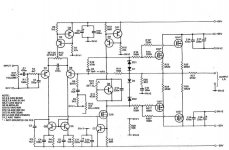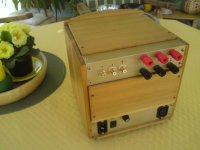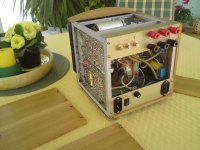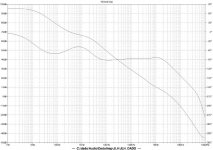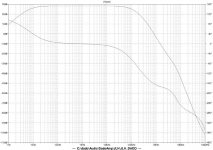hi Lineup,
i did get some 2sk216's to try, (your reccommendation) but still have not got around to trying them out.
trouble is i just have not had the time, but be assured i will at some stage give them a go.
i did get some 2sk216's to try, (your reccommendation) but still have not got around to trying them out.
trouble is i just have not had the time, but be assured i will at some stage give them a go.
hi Andrew,
thats where i got mine from, if you manage to get them at lower cost i would be interested.
I was thinking of a class a head phone amp using this device
thats where i got mine from, if you manage to get them at lower cost i would be interested.
I was thinking of a class a head phone amp using this device
hi Andrew,
thats where i got mine from, if you manage to get them at lower cost i would be interested.
I was thinking of a class a head phone amp using this device
thats where i got mine from, if you manage to get them at lower cost i would be interested.
I was thinking of a class a head phone amp using this device
burbeck said:hi Lineup,
i did get some 2sk216's to try, (your reccommendation) but still have not got around to trying them out.
trouble is i just have not had the time, but be assured i will at some stage give them a go.
Yeah I will get some of these ordered. Much lower Crss (miller feedback) capacitance than the verticals. Provided they have more current through them x3 or x4 you could also get near equal transconductance.
A good feature of these btw, is the negative tempco around 20mA. Should be able to disregard the degeneration resistor for more 2nd harmonic (39r I think it is) and protection transistor. ie. easier to implement.
Kevin
these lateral TO-220 mosfet
2SK213 2SK214 2SK215 2SK216
are simply great
I will order some too
because for pre amp / headphone amp, one pair will drive
for power amp, we can use these for VAS
or, as you say, even for output stage .. if parallel
www.dalbani.co.uk ... in United Kingdom
has got these NMOS ( 2SK213/214/215/216 )
datasheet:
http://documentation.renesas.com/eng/products/transistor/rej03g0903_2sk213ds.pdf
http://www.dalbani.co.uk/catalogue/product_details.php?id=6438
http://www.dalbani.co.uk/catalogue/product_details.php?id=6444
http://www.dalbani.co.uk/catalogue/product_details.php?id=6450
http://www.dalbani.co.uk/catalogue/product_details.php?id=6454
and the complementary PMOS ( 2SJ76/78/79 )
datasheet:
http://documentation.renesas.com/eng/products/transistor/rej03g0122_2sj76ds.pdf
http://www.dalbani.co.uk/catalogue/product_details.php?id=5901
http://www.dalbani.co.uk/catalogue/product_details.php?id=5903
http://www.dalbani.co.uk/catalogue/product_details.php?id=5904
Prices, does not come very Cheap
but Remember THIS: Quality does Cost Money!!! 😎
2SK213 2SK214 2SK215 2SK216
are simply great
I will order some too
because for pre amp / headphone amp, one pair will drive
for power amp, we can use these for VAS
or, as you say, even for output stage .. if parallel
www.dalbani.co.uk ... in United Kingdom
has got these NMOS ( 2SK213/214/215/216 )
datasheet:
http://documentation.renesas.com/eng/products/transistor/rej03g0903_2sk213ds.pdf
http://www.dalbani.co.uk/catalogue/product_details.php?id=6438
http://www.dalbani.co.uk/catalogue/product_details.php?id=6444
http://www.dalbani.co.uk/catalogue/product_details.php?id=6450
http://www.dalbani.co.uk/catalogue/product_details.php?id=6454
and the complementary PMOS ( 2SJ76/78/79 )
datasheet:
http://documentation.renesas.com/eng/products/transistor/rej03g0122_2sj76ds.pdf
http://www.dalbani.co.uk/catalogue/product_details.php?id=5901
http://www.dalbani.co.uk/catalogue/product_details.php?id=5903
http://www.dalbani.co.uk/catalogue/product_details.php?id=5904
Prices, does not come very Cheap
but Remember THIS: Quality does Cost Money!!! 😎
After meny years I decided to "improve" JLH 80W MOSFET amp from 1984.
Imade to amplifier with 3 channels in each one. It were used as amplifiers for active loudspeaker. Sound was nice, but I have had some problems with it. To sensitive, 37dB of gain, for my preamp with gain of 20dB.
When I decided to try improvement I simulated it wit LTSpice. As I had no models for original BJTs I used, for small signals BC546/556, and for small MOSFET BSS123.
Simulation of original JLH amp was not promising, probably I used different transistors in the simulation, but ot can't be to fare.
After that I changed following:
Gain lowered to 29dB by changing R14 from 150k to 56k.
R1 changed from 150k to 56k and moved parallel to C2
R10 removed and C8 in series with 100ohm and ten parallel to R14
C changed from 100pF to 330pF
C4 removed
C11 changed from 1nF to 47nF
parallel to R13 connected capacitor 10nF
Simulated distortion
JLH 3kHz 0.028429% , 20kHz 0.114783%
JLH moded 3kHz 0.002066% , 20kHz 0.030721%
I tested wit square signal and capacitive loading parralel to 8ohm
with 10nF no ringing
with .1uF some very small ringing
with 1uf some ringing but it is acceptable
If someone interested I can make a photo of it.
Now with the new JLH there no hum and no noise if I listning close to loudspeaker.
Better paired with preamp, and wat abouth sound - I LIKE IT.
No transistor was changed.
dado
Imade to amplifier with 3 channels in each one. It were used as amplifiers for active loudspeaker. Sound was nice, but I have had some problems with it. To sensitive, 37dB of gain, for my preamp with gain of 20dB.
When I decided to try improvement I simulated it wit LTSpice. As I had no models for original BJTs I used, for small signals BC546/556, and for small MOSFET BSS123.
Simulation of original JLH amp was not promising, probably I used different transistors in the simulation, but ot can't be to fare.
After that I changed following:
Gain lowered to 29dB by changing R14 from 150k to 56k.
R1 changed from 150k to 56k and moved parallel to C2
R10 removed and C8 in series with 100ohm and ten parallel to R14
C changed from 100pF to 330pF
C4 removed
C11 changed from 1nF to 47nF
parallel to R13 connected capacitor 10nF
Simulated distortion
JLH 3kHz 0.028429% , 20kHz 0.114783%
JLH moded 3kHz 0.002066% , 20kHz 0.030721%
I tested wit square signal and capacitive loading parralel to 8ohm
with 10nF no ringing
with .1uF some very small ringing
with 1uf some ringing but it is acceptable
If someone interested I can make a photo of it.
Now with the new JLH there no hum and no noise if I listning close to loudspeaker.
Better paired with preamp, and wat abouth sound - I LIKE IT.
No transistor was changed.
dado
Attachments
hi dado
thanks for sharing your mods to this amp they are very interesting.
its been quite some time since i had thoughts of moding this amp, and for one reason or another i have not got round to it. however i have now purchased a set of Hart pcbs and started putting together another amp this one i will mod and experiment with.
i just could not bring myself to not have sounds so i decided this way would be better.
thanks for sharing your mods to this amp they are very interesting.
its been quite some time since i had thoughts of moding this amp, and for one reason or another i have not got round to it. however i have now purchased a set of Hart pcbs and started putting together another amp this one i will mod and experiment with.
i just could not bring myself to not have sounds so i decided this way would be better.
Listening modified JLH 80W
After almost one months of listening I am very satisfied with sound quality. It is very quite with no hum or noise. I am listening it for hours without listening fatigue.
Here is LTSpice file how I simulated it and a few photos of the finished amps. There are two boxes with three channel in each one. It was intended for ative loudspeakers but for the moment I use it as monoblocks to drive passive loudspeakers as on photo.
dado
After almost one months of listening I am very satisfied with sound quality. It is very quite with no hum or noise. I am listening it for hours without listening fatigue.
Here is LTSpice file how I simulated it and a few photos of the finished amps. There are two boxes with three channel in each one. It was intended for ative loudspeakers but for the moment I use it as monoblocks to drive passive loudspeakers as on photo.
dado
Attachments
I have the wireless world for june july and aug 82 for the details on building the JLH 80w amp .....but I dont have the corrections that were printed in the sept 82 edition . Can anyone possible send me those . I believe they were on page 63..Dave
Hi all,
I’ve bought the Hart boards a long time ago to make a stereo version of the amplifier. I originally used the Hart components to build the amplifier, but was not satisfied with the sound, and stopped using it. One year ago, I decided to give it a second chance and started to replace a series of components, including more serious input and output cabling. I replaced definitively the associated awful preamp with the B1 from Nelson Pass. Now I find this little gem exceptionnally musical despite his age, totally beyond expectation. I’ve not been able to thank the designer as he passed away some years ago, but I’m understanding that there were some other contributors that deserve a merit.
I’ve a problem with a ground loop (heard in one speaker only) that I’ve not been able to remove until now. I’m still looking at this point.
I’m now beginning to build a new mono version from Hart boards, to gain the full potential of this design. The first problem naturally encountered is collecting the parts, some being obsolete and hard to find. The task is difficult but not impossible! The second one is replacing the still existing parts by those giving an improved result. The third is to find people still interested in this amp...
I hope to find here some actual amateurs and connoisseurs to help and share their experience, whatever it is. I’m not a technical one, so I cannot really help for a discussion about electronics, but can share some bits of my own little experience.
I’ve bought the Hart boards a long time ago to make a stereo version of the amplifier. I originally used the Hart components to build the amplifier, but was not satisfied with the sound, and stopped using it. One year ago, I decided to give it a second chance and started to replace a series of components, including more serious input and output cabling. I replaced definitively the associated awful preamp with the B1 from Nelson Pass. Now I find this little gem exceptionnally musical despite his age, totally beyond expectation. I’ve not been able to thank the designer as he passed away some years ago, but I’m understanding that there were some other contributors that deserve a merit.
I’ve a problem with a ground loop (heard in one speaker only) that I’ve not been able to remove until now. I’m still looking at this point.
I’m now beginning to build a new mono version from Hart boards, to gain the full potential of this design. The first problem naturally encountered is collecting the parts, some being obsolete and hard to find. The task is difficult but not impossible! The second one is replacing the still existing parts by those giving an improved result. The third is to find people still interested in this amp...
I hope to find here some actual amateurs and connoisseurs to help and share their experience, whatever it is. I’m not a technical one, so I cannot really help for a discussion about electronics, but can share some bits of my own little experience.
Thanks dadod ! Your project is very nice and the building is original.
I need some explanation to understand the effects of your mods, because, as I told in my first post, I’m still learning...
Please note that I’m using the schema from 1989, as used for Hart boards.
I’m looking for a more modern part of VN1210M to have improved characteristics. Have you found something interesting ?
I need some explanation to understand the effects of your mods, because, as I told in my first post, I’m still learning...
Please note that I’m using the schema from 1989, as used for Hart boards.
I’m looking for a more modern part of VN1210M to have improved characteristics. Have you found something interesting ?
vac231,
Schemtic I use is from 1984, but it is almost the same as from 1989, same values are different, but diagram and PCB is same. In my amp I use VN1210m but in simulation I used BS123 as I did not have model for VN1210. In earlier post you can find some suggestion for small MOSFET. I do not think that you will get mutch improved characteristics with different MOSFET. If you have VN1210 use it.
I have found more improvements in changing compensation, you can see it from my simulation. AS I do net have good enough test equipment for distortion test I did test with square signal and capacitive load and the amp was very stable, and the sound (during more then one months of sistening) is great.
dado
Schemtic I use is from 1984, but it is almost the same as from 1989, same values are different, but diagram and PCB is same. In my amp I use VN1210m but in simulation I used BS123 as I did not have model for VN1210. In earlier post you can find some suggestion for small MOSFET. I do not think that you will get mutch improved characteristics with different MOSFET. If you have VN1210 use it.
I have found more improvements in changing compensation, you can see it from my simulation. AS I do net have good enough test equipment for distortion test I did test with square signal and capacitive load and the amp was very stable, and the sound (during more then one months of sistening) is great.
dado
"I have the wireless world for june july and aug 82 for the details on building the JLH 80w amp .....but I dont have the corrections that were printed in the sept 82 edition . Can anyone possible send me those . I believe they were on page 63..Dave "
the 80Watt was not published in WW, it was in Everyday Electronics, however there was a few designs similar in WW by J L Linsley Hood
the 80Watt was not published in WW, it was in Everyday Electronics, however there was a few designs similar in WW by J L Linsley Hood
can anyone who made a revised version of JLH MOSFET 80W care to share a few words on how it sounds, pros & cons. just soundwise, regardless of how easy or difficult it's to made.
can anyone who made a revised version of JLH MOSFET 80W care to share a few words on how it sounds, pros & cons. just soundwise, regardless of how easy or difficult it's to made.
It is difficult to describe the sound of an amplifier because it is integrated in a full system... A few words however for that: powerful, fast, balanced and transparent, in my setup. All the virtues to listen to the music with joy and pleasure, or to build something musical around it. The sound improved a lot from the beginning as explained above. You can play with some components as usual. The only current drawback in my system is the ground loop issue.
It is difficult to describe the sound of an amplifier because it is integrated in a full system... A few words however for that: powerful, fast, balanced and transparent, in my setup. All the virtues to listen to the music with joy and pleasure, or to build something musical around it. The sound improved a lot from the beginning as explained above. You can play with some components as usual. The only current drawback in my system is the ground loop issue.
Maybe you have the same issue I had with JLH 80W amp before I modified it. Together with my modification I changed power supplay earthing. What JLH sugested in Electronic today august 1984 is wrong way to do earthing.
Connect midle of the transformer winding to the zero point of the large power supply capacitors and then from that point connect separate wire to the common chassis earth. Large current between winding and the capacitors should not go trough common earth point.
dado
thanks both - meanwhile i've purchased a heavily modified DIY-ed unit with intention to drive bass channels in my future multiway horn system. however i was so surprised with how it sounds that it now plays as the main amp with my geddes summa clones. it's very fast & transparent while nicely musical amp. maybe it's a synergy thing but it has a nice virtue in my setup that it beautifully follows the leading instruments (kinda tuneful), something that i usually hear with the good SE tubey gear. the rest of the system is myth (LDR with buffers) preamp, modified CD160 as a transport, m2tech young DAC.
- Home
- Amplifiers
- Solid State
- JLH 80w mosfet power amplifier - modifying it
